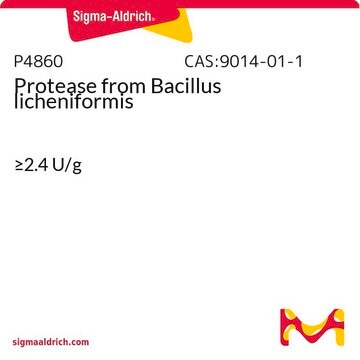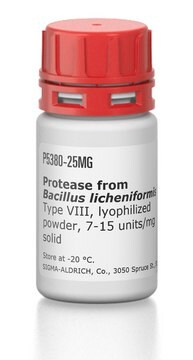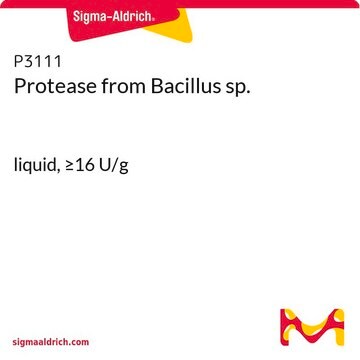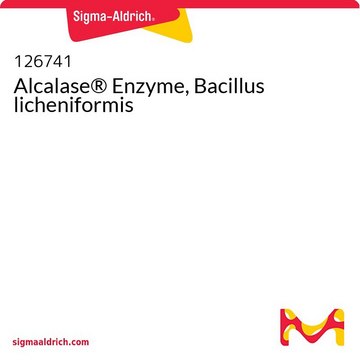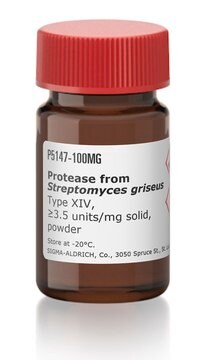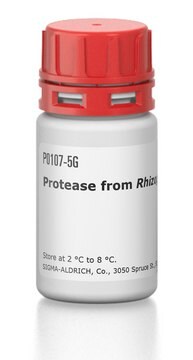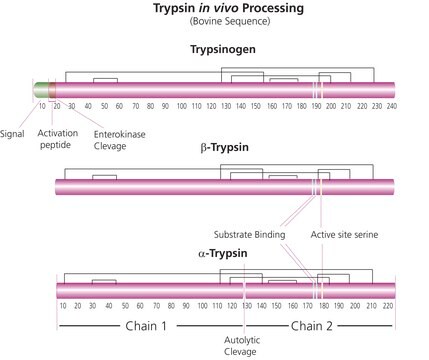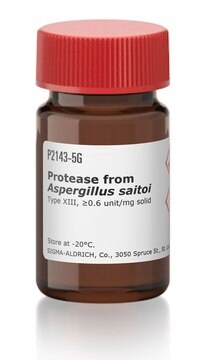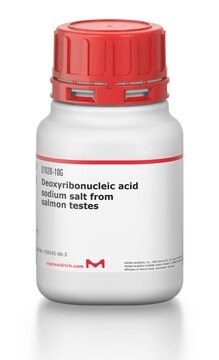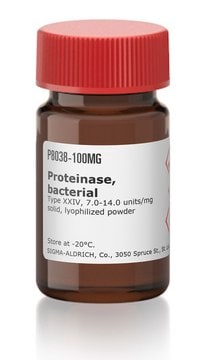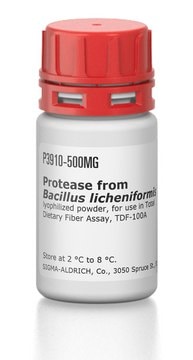Wszystkie zdjęcia(2)
Kluczowe dokumenty
P0029
Protease from Bacillus sp.
Synonim(y):
Protamex®
Zaloguj sięWyświetlanie cen organizacyjnych i kontraktowych
About This Item
Polecane produkty
pochodzenie biologiczne
Bacillus sp.
Poziom jakości
Formularz
granular
enzyme activity
>1.5 AU-N/g
temp. przechowywania
2-8°C
Szukasz podobnych produktów? Odwiedź Przewodnik dotyczący porównywania produktów
Opis ogólny
Protease from Bacillus sp. is extensively useful in pharmaceutical, leather, food and waste processing industry. It is widely used in manufacturing protein hydrolysates. Analysis of Bacillus protease stability and activity showed that the enzyme was active at all pH values from 5.0-11.0 with 100% activity at 8.0. Optimal pH for protein stability was determined to be at 7.0 while the optimal temperature for stability was at 60°C with 95% activity maintained.
Zastosowanie
Protease from Bacillus sp. has been used:
- to evaluate protease inhibitor activity
- in high yields in batch fermentation using a response surface methodology
- in a study to investigate a biosensor to detect a protease biomarker from Bacillus licheniformis
Komentarz do analizy
minimum activity 1.5 AU-N/G solid
Informacje prawne
Protamex is a registered trademark of Novozymes Corp.
Ta strona może zawierać tekst przetłumaczony maszynowo.
Hasło ostrzegawcze
Danger
Zwroty wskazujące rodzaj zagrożenia
Zwroty wskazujące środki ostrożności
Klasyfikacja zagrożeń
Eye Irrit. 2 - Resp. Sens. 1 - Skin Irrit. 2 - STOT SE 3
Organy docelowe
Respiratory system
Kod klasy składowania
11 - Combustible Solids
Klasa zagrożenia wodnego (WGK)
WGK 2
Temperatura zapłonu (°F)
Not applicable
Temperatura zapłonu (°C)
Not applicable
Wybierz jedną z najnowszych wersji:
Certyfikaty analizy (CoA)
Lot/Batch Number
Nie widzisz odpowiedniej wersji?
Jeśli potrzebujesz konkretnej wersji, możesz wyszukać konkretny certyfikat według numeru partii lub serii.
Masz już ten produkt?
Dokumenty związane z niedawno zakupionymi produktami zostały zamieszczone w Bibliotece dokumentów.
Klienci oglądali również te produkty
Production and properties of an extracellular protease from thermophilic Bacillus sp
<BIG>Nascimentol W, et al.</BIG>
Brazilian Journal of Microbiology, 35, 91-96 (2004)
Some properties of extracellular protease from Bacillus licheniformis LBBL-11 isolated from ?iru?, a traditionally fermented African locust bean condiment.
Olajuyigbe, FM.
African Journal of Biochemistry Research, 2, 206-210 (2008)
Sumant Puri et al.
Current microbiology, 44(4), 286-290 (2002-03-23)
High yields (1939 U/ml) of an alkaline protease were obtained in batch fermentation of a Bacillus sp. using a response surface methodology. The interaction of four variables, viz., starch, peptone, incubation time, and inoculum density, suggested inoculum density to be
Trypsin Inhibitor from Edible Mushroom Pleurotus floridanus Active against Proteases of Microbial Origin
<BIG>Ali PPM, et al.</BIG>
Applied Biochemistry and Biotechnology, 167-178 (2014)
Jan Paul Dudzic et al.
Cell reports, 27(4), 1050-1061 (2019-04-25)
The melanization response is an important defense mechanism in arthropods. This reaction is mediated by phenoloxidases (POs), which are activated by complex extracellular serine protease (SP) cascades. Here, we investigate the role of SPs in the melanization response using compound
Nasz zespół naukowców ma doświadczenie we wszystkich obszarach badań, w tym w naukach przyrodniczych, materiałoznawstwie, syntezie chemicznej, chromatografii, analityce i wielu innych dziedzinach.
Skontaktuj się z zespołem ds. pomocy technicznej

